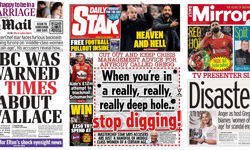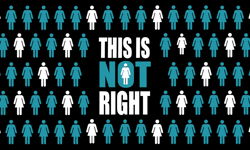Throughout my career, as first a journalist and then in PR, I have believed profile is good for the publications or the businesses I have served.
Many managers will judge the success of that PR entirely on the basis of increased circulation or new business leads, but it is so much more than that.
At the News of the World, we set out to create the image that the News of the World was full of passion and commitment - and I am not talking about the wife swapping clubs here!
Staff were encouraged to talk up their stories, enthuse about the positive impact the paper had on its readers’ lives and society as a whole (we had over 100 villains jailed in my five years as editor), and defend the publication’s stance on a variety of issues.
I believe the astonishing trail of exclusives we recorded was in part due to that PR campaign. For a start, the staff became incredibly confident – they cracked stories that other papers had failed to master, their contacts were far more proactive because they wanted to be a part of the ‘buzz’, and the media in general began to call us every Saturday night expecting a big scoop.
Who can forget Lady Buck and the Chief of Defence; the Jeffery Archer story that led him into the dock at the Old Bailey or the Robin Cook affair? There was also the bizarre Divine Brown / Hugh Grant affair in which we stuck wanted posters all over Hollywood.
Our rivals actually began to believe that such was the momentum and confidence of our operation, that it was a foregone conclusion that we would scoop up any big story out there.
Divine Brown did end up in the clutches of our brilliant American editor Stuart White and there was much rejoicing at the News of the World, which was then under the stewardship of Piers Morgan, with me as his deputy.
We had, however, overlooked one point. Rupert Murdoch saw the posters in Los Angeles and was on the phone like a shot to announce: "I have just signed Hugh Grant for 20th Century Fox." We had to negotiate with him that on that basis the story was better off in our hands and, despite having a story the world wanted, it appeared as only a two-page spread in the paper. The PR did the rest and we sold by the bucket load.
Somehow – and I am not sure how to explain this – we began to believe our own publicity. And as we believed, so the paper built an irrepressible momentum. I remember one conversation with the proprietor Rupert Murdoch when he said: "On your first 11 pages there is a front page splash on every page."
Media commentators used to say how lucky we were to have the resources to reel in scoop after scoop. Stories abounded about the safe full of secret scoops involving cabinet ministers and rock stars and, to be frank, we did nothing to persuade the chattering classes otherwise, although it was completely untrue.
We threw parties at the Conservative and Labour Party conferences and such luminaries as Michael Heseltine and Margaret Thatcher, Tony Blair and Robin Cook, would join us - more to find out what we were up to than share a glass or two.
That buzz knocked down the barriers and, for the first time, the News of the World was nominated for Newspaper of the Year (we came second by one vote). In our citation, while others were nominated for best foreign reporting or best photography, our citation said simply: The News of the World is nominated for its sheer excitement.
Impact on circulation
Those big stories led to a huge success in the circulation wars. When I took over the News of the World editorship in September 1995, the paper’s circulation was equal to that of the Sunday Mirror and Sunday People joined together. When I left five years later, the gap over those two rival red tops was close to one million.
I hired the first ever full time PR person to serve a newspaper. Her name is Hayley Barlow and she is still with the News of the World.
We created a media frenzy around our stories by breaking big exclusives, but holding back information for a second installment the following week. Hayley would brief newspapers and other media outlets so the story’s profile meant the public were gagging for the follow up.
When we exposed the directors of Newcastle United for misbehaving in Spain and criticising their own supporters and players (they referred to Alan Shearer as Mary Poppins), we sent a near 100 per cent increase in supplies to the town but they were sold out by 9am.
We also promoted our leading writers. Clive Goodman became a well-known royal commentator, managing editor Stuart Kuttner became the moral guardian when we were exposing paedophiles and everyone from the Prime Minister to the Archbishop of Canterbury wrote for us.
Indeed, the Archbishop invited me to his Millennium address at St Paul’s Cathedral and, when the service was over, he walked past political leaders and dignitaries and stopped at our pew for a chat. It became part of the folklore and the buzz that we created around the News of the World.
Reviving Hello!
I moved to become editor in chief of Hello!, where a market leader had been roundly trounced by its young upstart, OK!.
The proprietor had always been wary on PR-ing his product through fear he would lose some of the exclusivity that his publication enjoyed on their big scoops. But they were in danger of being so exclusive that nobody actually knew when they did win the race for a big story.
In my second week, I attended a Press Complaints Commission soiree attended by Prince Charles and Prince William. After a few glasses of Champagne too many, an OK! staffer told me how they planned to rub my nose in it with a big Celine Dion exclusive shoot with her new baby.
I went to a phone box and called a contact in the States. Within 10 minutes I was on a conference call with Celine’s agent and her husband. Two hours later I faxed them a contract and, within a week, I was at their beautiful home in Jupiter, Florida.
At Hello! we conducted TV interviews that went around Europe, coast to coast in America and gave our front cover to all the national newspapers. My proprietor was concerned he had given away his scoop – until he saw the circulation figures – up 60 per cent in the UK, 100 per cent in America, France was crazy and Canada, where Celine’s prime home was, could not get enough.
Thank you my Sun
Staff morale was buoyant and the scoops flowed in – Bob Geldof on safari with his children was particularly memorable because David Yelland, then editor of the Sun stole the front cover and made it his entire front page. Bob Geldof called me with his usual tirade of abuse, the proprietor wanted to sue News International.
Then came the sales figures – we were up more than 30 per cent and the thieves were suddenly our friends. Others quickly followed - at home with Zara Phillips and her then boyfriend, Pierce Brosnan’s wedding, and on it went. Rod Stewart’s girlfriend Penny joined the magazine as a roving photographer and major Hollywood stars were calling me at home to ask whether we were interested in them appearing in our magazine.
We won international magazine of the year and re-established the magazine in a pre-eminent position against OK! The turnaround took just a year.
Why PR matters
Editors like Jane Johnson at Closer and Mark Frith at Heat have enjoyed similar successes with astute use of PR, but, as I said earlier, it is so much more than simply about circulation success.
The magazine and newspaper world is one of the toughest jungles to live in. It is dog eat dog and it is so easy to be devoured by the pack. Good PR breeds confidence among the staff, makes the market believe in your product and begins a buzz that can have a huge positive effect.
It is not an overnight success strategy, but it can work quickly and effectively, provided the PR and marketing is put to the top of the priority list and is on the agenda at every features conference.
Too often it is a last-minute consideration. In my view it should be as important as any front page story.
FEATURE
The PR effect
What good is your big exclusive if no one knows about it? Your front page can help hype the story and shift extra copies, but it is pre-publicity that will make the biggest impact on sales. PR can be a highly effective way of generating that publicity and, says Phil Hall, the positive impact of good PR stretches far beyond the sales figures.










